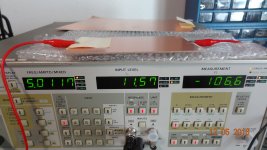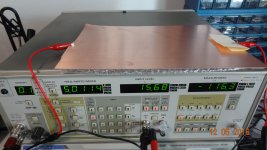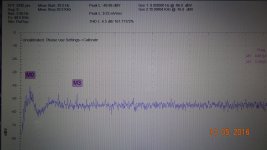... a website + payment system. Too much hassle for probably only a few customers.
Perhaps Hanspeter, the author of HpW Works, could tell me if it's worth all the effort.
When JesH has his hardware ready to sell could you both use the same website?
They seem a natural match and once the site is done it's easy to add one extra product.
Or via Hanspeter's site, if the product isn't too close to direct competition.
Or use the DIYaudio vendors forum?
I like the LTspice business model where it's free and full function but they still have a business benefit.
Unfortunately I don't see how this can work for you, and balance my desire for a free copy with the fair return you deserve.
Best wishes
David
Hi David,
>When JesH has his hardware ready to sell could you both use the same website?
I think it's always a good idea to combine our mutual efforts.
But what about protecting the software by means of a "product key". It means a lot extra hassle and, as we all know, it will be cracked sooner or later anyway. That's why I'm inclined to offer it as shareware.
Cheers, E.
PS: I started this project about 15 years ago. In those day I would be glad with some profits from DiAna. Nowadays however (remember, I'm 73 year old!), I care far less about a little extra money.
>When JesH has his hardware ready to sell could you both use the same website?
I think it's always a good idea to combine our mutual efforts.
But what about protecting the software by means of a "product key". It means a lot extra hassle and, as we all know, it will be cracked sooner or later anyway. That's why I'm inclined to offer it as shareware.
Cheers, E.
PS: I started this project about 15 years ago. In those day I would be glad with some profits from DiAna. Nowadays however (remember, I'm 73 year old!), I care far less about a little extra money.
Last edited:
How do you get rid of 3H in an amplifier? I retuned the ShibaSoku AG16B generator using the ShibaSoku 725D and its monitor output going to a QA400 FFT.
Got the 2nd down into the noise floor of the analyzer but 3H is still hanging tough at -136dBv.
BTW -- how do i also get rid of the 498Hz 'clock' or signal which is always in the data.
View attachment 548267
THx-RNMarsh
Richard can you repeat this at 2Khz and see if the third H reduces.
If it does then it's a residual in the 725D.
That was exactly my initial plan. But I'm dreading the idea of implementing a product key or dongle for the paid version and building a website + payment system. Too much hassle for probably only a few customers.
Perhaps Hanspeter, the author of HpW Works, could tell me if it's worth all the effort.
Cheers, E.
Yes it's all in the numbers. If you can sell 50 at say € 80 you can have someone else build you the website and payment system and you still have something to take the GF out on a fancy night.
It's uphill from then on, think of selling hundreds! It's a huge world out there ;-)
Jan
Last edited:
That's certainly a viable option, perhaps even the best. But to whom?[..]
Edmond.... can you sell the whole bundle to someone else and take a royalty... they do the work of selling it?
I don't know people or companies who might be interested.
Cheers, E.
To companies with similar products. All the engineering has been done for them. Yet, they have the marketing/sales and mfr'ing.
Document the performance with a brief description and see if they are interested. Later, if they respond/reply, let them know you will consult and help but on a limited basis and for royalties on sales.
-RNM
Document the performance with a brief description and see if they are interested. Later, if they respond/reply, let them know you will consult and help but on a limited basis and for royalties on sales.
-RNM
A realistic look at the marketplace would suggest there isn't a lot to be had in the market.
If you sell it you need to support it. Support can be a real black hole. You find yourself supporting many hardware setups and customers are complaining its not working right. At $500 ea you may sell 10-20? Thats a lot of hassle.
Offer it as freeware with no support. Its a hobby but if it doesn't work no risk and limited bad feelings. Maybe follow Bill Waslo's model and package it with a USB audio interface and sell through Parts Express.
If you sell it you need to support it. Support can be a real black hole. You find yourself supporting many hardware setups and customers are complaining its not working right. At $500 ea you may sell 10-20? Thats a lot of hassle.
Offer it as freeware with no support. Its a hobby but if it doesn't work no risk and limited bad feelings. Maybe follow Bill Waslo's model and package it with a USB audio interface and sell through Parts Express.
Richard-
First trick- turn down the output with the level vernier and see if the distortion drops (It did for me). Second, the attenuator switches could affect things. You need to run the analyzer at 3V in for best results.
Third, tweak the frequency vernier and see if that affects the distortion.
The offsets and other trims all affect the output. Finding the right balance is something of a trial and error process. it seems the lowest distortion is with a small DC offset. I'm not sure why.
First trick- turn down the output with the level vernier and see if the distortion drops (It did for me). Second, the attenuator switches could affect things. You need to run the analyzer at 3V in for best results.
Third, tweak the frequency vernier and see if that affects the distortion.
The offsets and other trims all affect the output. Finding the right balance is something of a trial and error process. it seems the lowest distortion is with a small DC offset. I'm not sure why.
AG16. From experience.
Sent from my SGH-M919 using Tapatalk
Yes.
I believe you said the same about the offset in the impedance convertor of the 725.
When attempting to generate ULDistortion, dont forget the pcb material. If you use a ground plane under traces, the non-linear C from trace to grnd plane below could be a limiter;
Here is a 4.5" x 6" pcb at 5KHz. It has increased THD from below -130 to -107dB. More than 23dB degradation.
THD was higher by 15dB at 1KHz.

A much larger piece of PCB with very thin (paper thin) fleible dielectric seperating the two thin plates (total C=7.5nF) has lower THD (-116dB).

For our project, we ought to use the lowest THD material for pcb. These are just 2 tests of pcb i had lying around. Not the best we can use.
THx-RNMarsh
Here is a 4.5" x 6" pcb at 5KHz. It has increased THD from below -130 to -107dB. More than 23dB degradation.
THD was higher by 15dB at 1KHz.

A much larger piece of PCB with very thin (paper thin) fleible dielectric seperating the two thin plates (total C=7.5nF) has lower THD (-116dB).

For our project, we ought to use the lowest THD material for pcb. These are just 2 tests of pcb i had lying around. Not the best we can use.
THx-RNMarsh
Last edited:
When attempting to generate ULDistortion, dont forget the pcb material. If you use a ground plane under traces, the non-linear C from trace to grnd plane below could be a limiter;
Here is a 4.5" x 6" pcb at 5KHz. It has increased THD from below -130 to -107dB. More than 23dB degradation.
THD was higher by 15dB at 1KHz.
View attachment 548597
A much larger piece of PCB with very thin (paper thin) fleible dielectric seperating the two thin plates (total C=7.5nF) has lower THD (-116dB).
View attachment 548598
For our project, we ought to use the lowest THD material for pcb. These are just 2 tests of pcb i had lying around. Not the best we can use.
THx-RNMarsh
Can you repeat this test but in in enclosed metal box grounded to input ground of the analyzer?
yes.
It did not change the THD of the pcb capacitance at all.
Note I am only using the pcb as a coupling cap from gen output to analyzer input.
-RNM
It did not change the THD of the pcb capacitance at all.
Note I am only using the pcb as a coupling cap from gen output to analyzer input.
-RNM
Last edited:
yes.
It did not change the THD of the pcb capacitance at all.
Note I am only using the pcb as a coupling cap from gen output to analyzer input.
-RNM
In that first example, what is the capacitance of the PCB?
What is the frequency of the fundamental?
What is the 3 dB down point of the HPF that is formed by use of the PCB capacitance as a coupling capacitor?
What is the generator voltage?
If you increase the signal level by 6dB, by how many dB does the THD go up (or down)?
Cheers,
Bob
- Home
- Design & Build
- Equipment & Tools
- Low-distortion Audio-range Oscillator
